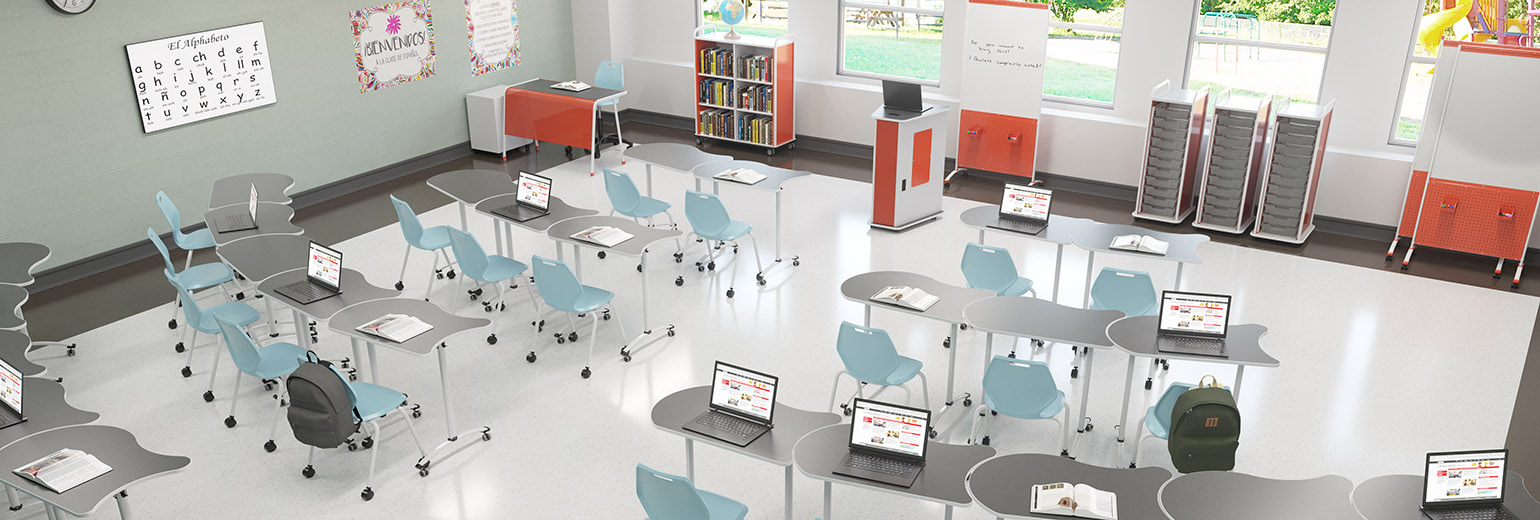Teaching is a complex art. There are many strategies and modalities that teachers can use to develop students’ skills and convey critical information—and successful teachers weave all of these together into a intricate tapestry of classroom techniques and practices. To do this effectively, however, teachers need an agile classroom environment that can quickly adapt to serve many functions.
Flexible groupings
A key challenge for educators is that students learn at different paces and have unique learning needs. To differentiate their instruction and meet these various needs, good teachers will use a mix of whole class, small group, and individual instruction.
For instance, a teacher might demonstrate a concept to the entire class at the beginning of a lesson, then have students break into smaller groups to discuss the concept or practice the skill. During this time, the teacher might also work one-on- one with some students who need extra help or attention.
A strategy that has become very popular in recent years is the idea of “flexible grouping.” This is where the teacher creates temporary groups that can last for one activity, a whole class period, or longer. The students work together in multiple configurations, depending on the activity and the desired learning outcomes.
“Teachers are discovering that grouping and regrouping students in a variety of ways throughout the school day actually makes their job easier and makes their students more productive,” notes education writer Janelle Cox for TeachHUB. “Flexible grouping is more than just moving a student’s seat; it is practical way to differentiate (instruction) as learning needs dictate.”
Teachers use this strategy, she writes, “because it’s a great way to meet the academic, social, and emotional needs of each student—and it allows …students to have the opportunity to work with, and learn from, their peers in a way that lets them feel comfortable contributing. When students work in a variety of groups, they learn to work independently and cooperatively with a variety of personalities.”
Direct vs. guided instruction
Another challenge for educators is balancing direct instruction, where they are imparting new knowledge or demonstrating a skill, with indirect or guided instruction, where they are allowing students to make discoveries, gather information, and infer meaning for themselves.
There are many types of guided instruction, such as inquiry-based learning (where teachers give students a guiding question to research or think about) or project-based learning (where teachers give students a task or challenge to solve). This kind of self-directed learning can be accomplished individually or through collaborative learning, in which students work together and learn from each other.
Guided instruction promotes active learning, where students are fully engaged in and responsible for their own education. Because research suggests this can be a more effective technique in helping students learn than simply listening to a lecture, teachers are spending a growing amount of their class time on guided instruction. But there are still times when direct instruction makes sense.
Education researcher Robert Marzano recommends a technique he calls “enhanced discovery learning,” in which teachers prepare students for self-directed learning and provide assistance along the way.
“Teachers must make sure that students have the necessary knowledge to negotiate the nuances of the content,” he wrote for ASCD’s Educational Leadership. “This might involve some direct instruction. For example, before asking students to consider how best to stretch the hamstring muscle in cold weather, the teacher might present a series of lessons to clarify basic facts about muscles and their reaction to changes in temperature.”
How agile learning spaces can help
Successful teachers are like orchestra conductors, understanding how these various strategies fit together and knowing when to shift fluidly from one to another—from whole group to small group or from direct to guided instruction and back again.
But making this transition effectively requires agile learning spaces that easily can support different modes of teaching and learning. For instance, student desks and tables that can be rearranged quickly into various configurations makes teaching with flexible groupings much easier.
Different modes of teaching and learning work best with different arrangements of the classroom space. Education researcher Tim Springer has described the relationship between various instructional modalities and the settings that best support them as follows:
(adapted from “Interaction & Space,” 2011: Human Environmental Research Organization: Bretford “Discovery Guide”)
Conclusion
The ability to transition seamlessly between different teaching strategies and modalities depends in part on how agile the classroom environment is.
Learning spaces that are flexible and can support a wide range of learning styles and activities—with furniture that can be rearranged to accommodate different groupings and flows of information quickly and easily—are critical in helping teachers navigate these various modalities.
– Cindy Eggebrecht


